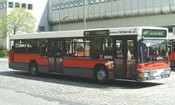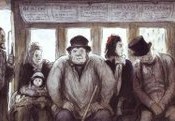Bus
A bus is a large automobile intended to carry numerous persons in addition to the driver and sometimes a conductor. The name is a shortened version of omnibus, which means “for everyone”.
Bus History
The omnibus, the first organized public transit system, may have originated in Nantes, France in 1826, when a retired army officer who had built public baths on the city’s edge set up a short stage line between the center of town and his baths. When he discovered that passengers were just as interested in getting off at intermediate points as in patronizing his baths, he shifted the stage line’s focus. His new voiture omnibus (“carriage for all”) combined the functions of the hired hackney carriage with the stagecoach that travelled a predetermined route from inn to inn, carrying passengers and mail. His omnibus featured wooden benches that ran down the sides of the vehicle; entry was from the rear.
Whether by direct emulation, or because the idea was in the air, by 1832 the idea had been copied in Paris, Bordeaux and Lyons. A London newspaper reported in July 4, 1829 that “the new vehicle, called the omnibus, commenced running this morning from Paddington to the City”. This bus service was operated by George Shillibeer.
In New York, omnibus service began in the same year, when Abraham Brower, an entrepreneur who had organized volunteer fire companies, established a route along Broadway starting at Bowling Green. Other American cities soon followed suit: Philadelphia in 1831, Boston in 1835 and Baltimore in 1844. In most cases, the city governments granted a private company — generally a small stableman already in the livery or freight-hauling business — an exclusive franchise to operate public coaches along a specified route. In return, the company agreed to maintain certain minimum levels of service, which did not include upholstery, however. The New York omnibus quickly moved into the urban consciousness. In 1831, New Yorker Washington Irving remarked of Britain’s Reform Act (finally passed in 1832): “The great reform omnibus moves but slowly.”
The omnibus had many repercussions for society, particularly in that it encouraged urbanization. Socially, the omnibus put city-dwellers, even if for only half an hour, into previously-unheard-of physical intimacy with strangers, squeezing them together knee-to-knee (illustration, left). Only the very poor remained excluded. A new division in urban society now came to the fore, dividing those who kept carriages from those who did not. The idea of the “carriage trade”, the folk who never set foot in the streets, who had goods brought out from the shops for their appraisal, has its origins in the omnibus crush.
The omnibus also extended the reach of the North Atlantic post-Georgian, post-Federal city. The walk from the former village of Paddington to the business heart of London in the “City” was a brisk one for a young man in good condition. The omnibus offered the nearer suburbs more access to the inner city.
More intense urbanization was to follow. Within a few years, the New York omnibus had a rival in the streetcar: the first streetcar ran along The Bowery, which offered the excellent improvement in amenity of riding on smooth iron rails rather than clattering over granite setts, called “Belgian blocks”. The new streetcars were financed by John Mason, a wealthy banker, and built by an Irish contractor, John Stephenson. The streetcars would become even more centrally important than the omnibus in the future of urbanization.
An early motorized bus – a Benz truck modified by Netphener company (1895)When motorized transport proved successful after c. 1905, a motorized omnibus was for a time sometimes called an autobus.
Buses began to replace streetcars in the U.S. because of a continuing series of technical improvements: pneumatic “balloon” tires during the early 1920s, monocoque body construction in 1931, automatic transmission in 1936, the diesel-engine bus in 1936, the first acceptable 50+ passenger bus in 1948, and the first buses with air suspension in 1953.
Bus services were a focal point in the American Civil Rights Movement of the 1950s and 1960s in the United States. In the period after the American Civil War’s end in 1865, racial segregation in public accommodations, including public transport such as rail and bus services, was enforced through Black Codes and Jim Crow laws. These were made to prevent African-Americans from doing things that a white person could do. For instance, Jim Crow laws required bus drivers to enforce separate seating sections. These laws and enforcement varied among communities and states. In 1955, after a long day of work, Rosa Parks, a black seamstress, was arrested in Montgomery, Alabama for refusing to give up her seat to a white man on a public bus, bringing attention to the injustice of differential and degrading treatment based solely upon race. This incident, boycotts of bus services, other protests, and court challenges led a U.S. Supreme Court ruling banning segregation on public buses and helped lead the U.S. Congress to the pass the landmark 1964 Civil Rights Act which clarified the unconstitutionality of public racial segregation laws.
In some areas of the United States, a forced busing system has been used to achieve racial desegregation of public schools. Under such a busing plan, children do not necessarily go to the nearest school geographically, but to such a public school in the same district where there is an appropriate mix of racial diversity.
Types of Bus Service
Buses are an intrinsic part of everyday life, and play an important part in the social fabric of many countries. Many urban public transportation systems rely on a bus network to provide services. The largest single city bus fleet in North America is in New York City.
Bus services can generally be categorized into several different categories. Local transit buses provide public transit within a city or one or more counties. Intercity and interstate buses provide transit specifically between cities, towns, rural areas, as well as between states. They generally provide far less stops then would be found on local bus routes. Greyhound Bus Lines and Trailways Transportation System are examples of interstate bus systems. Some local transit systems offer some intercity bus lines that provide transit from one city or town they service to nearby cities or towns served by another transit agency. Intercity bus services have become an important travel connection to smaller towns and rural areas that do not have airports or train services.
Some public transit bus systems offer express bus service in addition to local bus lines. While local lines provide frequent stops along a route, express lines make far fewer stops in order to speed up the travel time between key destinations on the route. For example, an express bus line may provide speedier service between a local airport and the downtown area of a nearby city.
Shuttle bus service provide transit service between two destinations, such as an airport and city center. Shuttle bus services are often provided by colleges, airports, shopping areas, companies, and amusement destinations.
Tour bus service provides transit for tourists to see areas of interest and notable sites by bus. City tour buses often simply pass by the sights while a tour narrator describes them while longer distance tour buses generally allow for passengers to disembark at each sight. Some places have buses that resemble streetcars in order to attract tourists or other designs for different appearance purposes.
School bus service provides transit to and from school for school students. Some private schools use school buses only for field trips or sports events. Some school systems, such as the San Francisco public school system, do not operate their own school bus system but instead rely on the local public transit bus system to provide transportation for the system.
Charter bus operators, provide buses with properly licensed bus drivers for hire.





